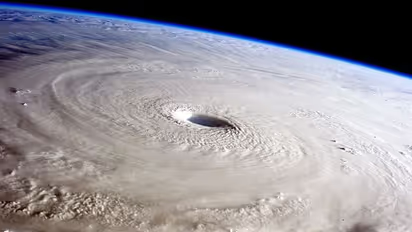India staring at super cyclones, extreme flooding?

Synopsis
If greenhouse gas emissions continue at the current pace, more than two and a half times (250 per cent) of India's population would experience flooding of greater than one metre, compared to the event in 2020, say experts
India is likely to face extreme impact of Super cyclones - cyclonic disturbances in which maximum wind speed is 222 km/h and above - in future because of climate change hazards, a study by a UK university said, adding if greenhouse gas emissions continued at the current pace, more than two and a half times (250 per cent) of India's population would experience flooding of greater than one metre, compared to the event in 2020.
Also Read: Climate alert! Massive coral bleaching in Andaman sea
Researchers from the University of Bristol examined the 2020 Super Cyclone Amphan and predicted its implications under several scenarios of sea-level rise caused by global warming. Cyclone Amphan, the first super cyclone to form in the Bay of Bengal since 1999, hit Bangladesh, and then West Bengal and Odisha in May 2020 killing many.
More than 2 million people were evacuated from their homes in Bangladesh, and nearly half a million in West Bengal and Odisha were moved to safer places from vulnerable low-lying areas to shelters. Amphan was said to be the costliest tropical storm ever recorded in the North Indian Ocean, and the strongest cyclone ever since the Odisha cyclone in 1999.
South Asia was one of the most vulnerable regions in the world and very little climate impact research has been done, despite the Intergovernmental Panel on Climate Change highlighting it as such a critical region, said Dann Mitchell, Professor of Climate Science at the University of Bristol, and the lead author of the study.
The research team, presenting a critical piece of evidence in support of ramping down greenhouse gas emissions, used sophisticated climate model projections to anticipate the scale of those affected by cyclones in the rest of this century. Although the increasing number of people at risk is anticipated to be more modest in Bangladesh, estimated to rise by 60 per cent to 70 per cent, this factors in declining coastal populations in the future, the researchers said.
The study noted that if the Paris Agreement -- a legally binding international treaty on climate change -- climate goals of 2 degrees Celsius warming above pre-industrial levels are adhered to, population exposure to flooding dropped close to zero in Bangladesh. But India, even in this scenario, showed an alarming increase between 50 per cent and 80 per cent, and the country was expected to experience flooding in the future, the researchers said.
What is Paris Agreement?
The Paris Agreement is a legally binding international treaty to tackle climate change. The objective of this global framework is to hold the global average temperature increase to well below 2 degrees Celsius above pre-industrial levels and endeavour to limit the temperature increase to 1.5 degrees Celsius.
"The latest IPCC report has mentioned with high confidence that tropical cyclones with higher intense categories will be more frequent in the future," said Saiful Islam, Professor of Hydrology at the Bangladesh University of Engineering and Technology (BUET), and contributing author of the study. He added that “population exposure in Bangladesh and India will be increased up to 200 per cent in the future for extreme storm surge flooding (greater than 3 metres) from intense cyclones under high emission scenarios."
How can we achieve the goals of the Paris Agreement?
A strong, rapid and sustained greenhouse gas reduction, according to the researchers, is essential to achieve goals of the treaty and to reduce losses and damages of highly vulnerable countries.
Also Read: Save Soil movement: Story of a civil engineer's organic coconut farm
Stay updated with the Breaking News Today and Latest News from across India and around the world. Get real-time updates, in-depth analysis, and comprehensive coverage of India News, World News, Indian Defence News, Kerala News, and Karnataka News. From politics to current affairs, follow every major story as it unfolds. Get real-time updates from IMD on major cities weather forecasts, including Rain alerts, Cyclone warnings, and temperature trends. Download the Asianet News Official App from the Android Play Store and iPhone App Store for accurate and timely news updates anytime, anywhere.